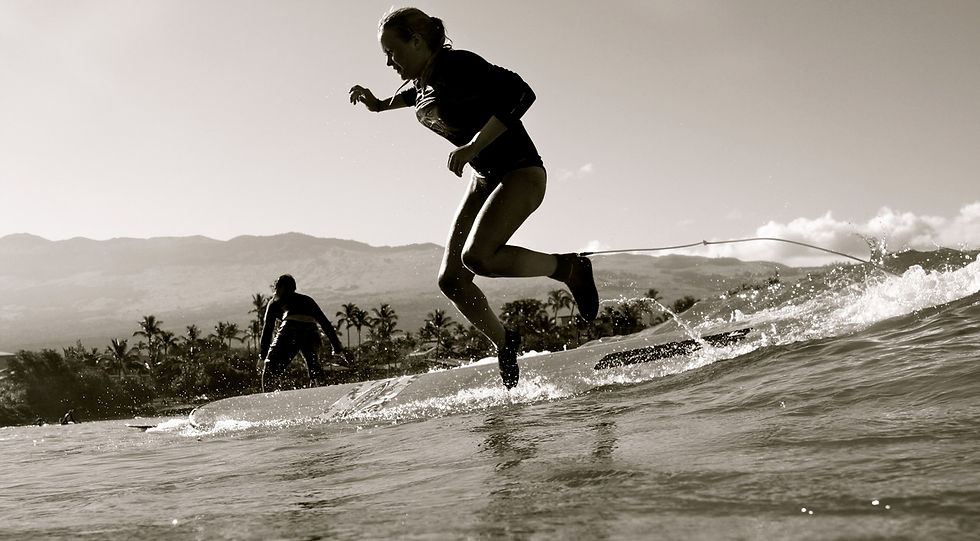How to Surf: Tips for Gnarly Travels
- thereseholland
- Apr 17, 2015
- 9 min read
For many, learning how to surf happens while on vacation or while travelling to a place that’s famous for its sick waves. Whether you're going on a family vacation in Hawaii, doing solo travel in Costa Rica, or trying it out at your own local beach, there are a few tips I can share to make sure your first time doesn't suck.
I'm incredibly pumped to share these tips with you, beecause it allows me to write about my two favorite things in the entire world: travelling and surfing!

Pure Bliss in Kihei, Hawaii
1. Research the spot. First off, just because a place is famous for its surf, does not mean every place will be good for surfing. Some spots are better for beginners, others are for pros. Additionally, there are plenty of beaches that won't have waves for surfing, or won't have waves at all. Just because you're at a beach in Hawaii does not mean there will be suitable waves for surfing, or suitable waves for your level of surfing.
I like SurfSleepTravel as a good place to browse the spot. It's also great to help if you want to find a surf camp or plan a vacation that will focus on surfing. Read the reviews on sites like SurfSleepTravel, and see which spots are good for beginners, and what time of year to go. Depending where you go, waves are not always predictable and consistent. It's good to see both which beaches are okay for your level, as well as the peak season of surf. Sometimes, a spot may be better in Spring than Summer, or even Winter, so it's good to have as much knowledge as possible so you don't get your hopes up.
Additionally, you should check the weather and surf forecast to make sure the day is good for surfing. There are plenty of surf forecasts online to tell you what the waves are predicted to be like paired with temperatures of the ocean and general climate.
2. Be in shape. Someone once told me if I ever wanted to be a great surfer, I needed to be able to do 100 pushups. Yeah.
Hate to break it to you, but surfing is a sport. Like any sport, if want to be good, you need to work out. Obviously you can surf without being able to literally do this, but this point perfectly emphasizes the connection between physical fitness and surfing. Arm strength is important for paddling out in the water and pushing yourself up on the board. Physical stamina is necessary to do this more than one time. If you can barely do a pushup, how can you expect to push up on a board in the ocean after paddling through waves breaking in your face?
PROTIP! Take long, steady strokes with palms cupped while keeping the rest of your body immobilized. Slow and strong strokes are better than fast, shallow ones.
Working out is fun when you involve your friends.
Instagram @tessholla
Exercise such as yoga or pilates can help you with balance, which will be important as well (these practices offer core and arm strength as well). Once you've paddled out and pushed yourself up, you'll want to stay up, right? Understanding balance will help with that.
PROTIP! A helpful term to understand is "corking.” Corking is needed when someone puts weight on the tail of the board. The front, or nose, will stick up. Try to edge up on the board to balance out to avoid dragging or falling as a result.This is very normal for beginners to experience, and will get better with balance training.
But hey, don’t let all this get you down if you’re not currently working out. What better motivation is there than working out to be in shape to have fun in the ocean? You got this, sexy future surfer!
3. Dress the part. Depending where you are going, you may need to wear different things. Surfing in Hawaii could mean you just need a rash guard (a special shirt to protect your skin from getting scraped up). Surfing in England, on the other hand, means a thick wetsuit to stay warm in the cold water. Local surf rental shops will have the right clothes to suit the needs of the location.
4. Know surf etiquette. You might not know that there are culural norms to surfing. In order to avoid being a "kook" (derogotory; person who does not respect surf etiquette) you need to know that there are some rules to follow in order to be respectful.
Under the assumption that you are a beginner, we don't need to get into too much detail here, as you will most likely be surfing in beginner spots with others on your same level. But, being a beginner does not mean you have a free pass not to follow some basic rules.
So here they are:
Respect others. If you happen to be in a spot with locals or people who are really good, know that you are at the bottom of the food chain, buddy. Show respect for those who've earned it. At this level, it is best to just stay away from intermediate and advanced surfers. Avoid annoying them, but also stay on waves that suit your level so you can stay safe.
Don't hog the waves! Share with others, and wait your turn. Do not "drop in" on someone. In other words, one wave per person. If you try to surf a wave someone else is already surfing, this is considered "dropping in" on them, and it's a real kook move. Protip: the "peak" is the breaking part of the wave. The person closest to the peak has "dibs" on it. Let them ride the wave.
If you've made a mistake, apologize! It's totally fine, and part of the learning process of anything.
5. Know how to bail out. Sometimes, you will want to bail out, or quit the attempt to surf a certain wave. To do this safely, jump away from the board and make sure your head is protected by your arms. Your leash is attached to both your foot and your board, so the board won't go flying away. However, your board could still hit you or another person so be aware.

Bailing.
6. Take photos! If you’re a millennial learning to surf, chances are, you will totally want this photographed. No shame! This is a safe place, so we can admit we'd love to snag a great future #tbt. Plus, if you've decided to surf while travelling, this could be a once in a lifetime moment!
Maybe you have a boring friend who will want to sit and watch on the beach, but if you want close up action shots the best bet is a waterproof camera. I love my GoPro and if you already have one, there's no better way to take surf photos. GoPro is great with their accessories for sports like surfing. Their Surf Mount is only ideal if you own your own board, so you could also try their Chesty chest harness. If you don't have a GoPro already, please don’t spend $300 on this one instagram photo, ya nerd). There's also waterproof disposables sold at convenience stores and many hotels and resorts.
You could also try finding a surf school that has a photographer. Many surf schools or camps have a photographer who takes photos of people while they learn (people are absolute geniuses on capitalizing on our narcissm). Depending on the school, you will probably have to buy the photos afterwards, but why not? For $20 you can have a lifetime of #tbts that make you look gnarly.
And while you're researching who will photograph you...
7. Compare surf school prices. Research many spots in advance by searching online. The first shop you see when you get off the bus might be the most expensive or most busy one. Often, it's possible to combine your accommodation with a surf lesson to save money. Additionally, see if there are group rates for you and your friends, or you and your gnarly mom. While group lessons can be great and tend to be cheaper, consider if you’re shy or want personal attention. In that case, a private or semi-private lesson might be better for you, though you will likely have to pay a bit more.
So you’ve trained hard for this moment, now you’ve rented the board and met the instructor, so why are you still reading? It's time to paddle out already, right? No! WRONG! I have one more tip that I want to get you guys in on before you paddle out.
Before we get to it, let me just say: if you just want to surf on your vacation just to do it once, snap a photo, and be done with it, well, kudos. Go on, paddle out. This tip is not for you. If you want to become a surfer, or at least become semi-decent at a new sport, I have one more tip that is vital if you want to keep surfing.
This tip is something the surfing instructors won’t tell you. Here it is:
8. Your instructor might not teach you how to surf correctly. Yep, hate to break it to you, but the actual method he or she teaches you will probably not be beneficial to you long term. This is because often, the instructors goal is to simply get you up one time, so they can claim to have delivered a successful lesson. They want the student to have stood up at least one time so said student can head home happy. Sometimes, in order to get the student standing on a board more quickly, the instructor will teach a bad form.
Let me explain.
When you get your first surf lesson, more likely than not, you will be learning on a “foamie”, or foam board. The “foamie” is just that - a surfboard with a soft foam construction. This means that they are more buoyant. The “foamie” is characteristically large, in length and width, making you more steady on the waves. Remember the balance thing I mentioned earlier? The foamie is wider, and will keep you more stable if your balance isn't perfect. Surf boards that are wider are more stable in the ocean, which is also why standup paddle boards are so big.

Me & a foamie in Cádiz, Spain. Notice that I am kind of struggling to hold the thing.
You will probably learn on a “foamie” due to how forgiving it is for the surfer, as it assists with balance a great deal. The typical board is made of polyurethane. My first attempt at surfing was on a short polyurethane board, and it was much harder than later attempts on a foam board. Long foamies will practically ensure you get up, even if you ignored my tips about balance and strength training.
The foamie will help you get up, but it will also allow you to “cheat” in how you get up.

(Gif credit here)
See what Ashley* did? She used her knees on a foam board. That’s fine, I’m not hating, but I am saying its not the best way to learn. The reason you’re tempted to use your knees is because it’s easier, and it requires less upper body work. Imagine (or actually try) pushing yourself up without the help of your knees. Now imagine, doing it on an unsteady board in the ocean. It’s harder.
This is where I get to my point about the instructors: they often will not correct you if you cheat. I mean, can you blame them? People can be so whiny, and the instructor just wants to make everyone happy. People are quicker to say "What a bad teacher!" than “Oh I guess I should have listened to Tess’s #2 tip on working out rather than eating cheetos and playing N64 all day!"**.
Besides, most people will never surf again after their first lesson, so why bother teaching them a more difficult way?***
So, your foamie will allow you to use your knees for assistance, but any other board will not be so forgiving. It will most likely fly out from under you if you try this, and you’ve lost the wave and now must wait for another one. If you learned to use your knees the first fews times on a foamie, it will be very hard to unlearn this. So, do not let your instructor fool you into thinking this is okay. Sure, it will make you get up sooner, and make him or her look great at the end of the day, but ultimately: you’ve picked up a terrible habit if you want to make surfing a lifestyle or hobby.
So, the stability of the foamie is both a blessing and a curse. Be aware of this, work out, practice balance, and you’re all set to paddle out! So get to it, my new gnarly friend!
How was your first time surfing? Have any tips I missed? Let me know in the comments below!
Footnotes
*No, I cannot tell the Olsens apart. I googled this. It’s Ashley.#
**To be fair, both cheetos and N64 are awesome. Don't listen to me. Do you.
**To be fair, I should say that not all instructors are like this.


























Comments